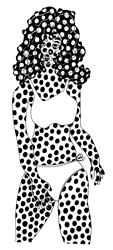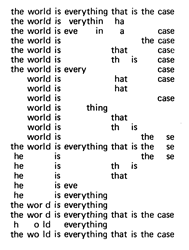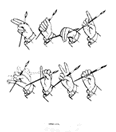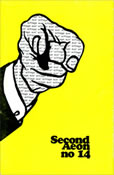|
Seco nd Aeon magazine began in 1966 and ran for nd Aeon magazine began in 1966 and ran for
twenty-one issues until the mid-seventies. It was edited by Peter Finch with occasional help on the review section from the late John Tripp. Originally established as a small mimeographed vehicle for the work of Finch and his circle second aeon soon became a major vehicle for the poetry revolution of the period. With financial aid from the Welsh Arts Council and the arts patron Cyril Hodges the magazine grew to become a fully printed magazine of several hundred pages in extent.
 Second aeon presented an overview of the poetries at large in these islands, supplementing this with large helpings of new work from America and, in verse translation, from Europe. Not much escaped the magazine’s concerns. Second aeon was filled with the new, the innovative, the visually experimental and the stuff that made the poetry world spin. If you wanted to read what was happening in 70s poetry then you looked here. Second aeon presented an overview of the poetries at large in these islands, supplementing this with large helpings of new work from America and, in verse translation, from Europe. Not much escaped the magazine’s concerns. Second aeon was filled with the new, the innovative, the visually experimental and the stuff that made the poetry world spin. If you wanted to read what was happening in 70s poetry then you looked here.
Not much escaped second aeon’s eye. Here is a listing from 1973 issue # 16/17:
The fat blue double. Cover by John Furnival. Features: the small press scene at enormous length, fiction from Alexis Lykiard, Opal L nations, Eric Mottram on the work of Bob Cobbing, Alison Knowles on spoken performance, a letters section, more on Poet's Conference. Poetry from Antipater of Sidon, Dannie Abse, Charles Bukowski, Jim Burns, William Burroughs, Julie Cashford, Cid Corman, Thomas A Clark, William Cox, Theodore Enslin, Clayton Eshleman, Peter Finch, Duncan Glen, Yannis Goumas, Bill Griffiths, David H W Grubb, Harry Guest, Marilyn Hacker, Cyril Hodges, Holderlin, Ena Hollis, Peter Jay, Nicki Jackowska, Peter Levi, Tim Longville, Ulli McCarthy, Edwin Morgan, Nossis. Peter Redgrove, Theodore Weiss, J.P.Ward, Hans Verhagen, William Sherman, John Riley, Barry Edgar Pilcher, John Ormond, Julio Ortega, Blas De Otero, Alan Perry, Tom Pickard, Malcolm Parr & many others.

A feature was the extensive Small Press Scene which attempted to track the entire little mag revolution, covering output of magazine and booklets in English from five continents. The sheer volume of small press material reaching Finch’s publishing base, a flat in Llandaff North, Cardiff, often threatened to overwhelm him.
The magazine was extended to include a large series of Cardiff public poetry readings (No Walls) and an extensive range of attendant publications in the form of second aeon publications which brought out seminal works by John Tripp, Bob Cobbing, J P Ward, Peter Redgrove, Douglas Blazek, Martin Booth, William Wantling, and others along with anthologies of found, sound and typewriter poetry.

Few back copies remain although some copies can be tracked through the second hand market. Issues 1 to 12 used mimeo while 13 onwards were spine-bound and fully printed. The 60s and 70s were technologically backward times yet second aeon was a beacon of illustration and innovation.

A full history of the magazine is available at http://www.peterfinch.co.uk/ | 








 nd Aeon magazine began in 1966 and ran for
nd Aeon magazine began in 1966 and ran for  Second aeon presented an overview of the poetries at large in these islands, supplementing this with large helpings of new work from America and, in verse translation, from Europe. Not much escaped the magazine’s concerns. Second aeon was filled with the new, the innovative, the visually experimental and the stuff that made the poetry world spin. If you wanted to read what was happening in 70s poetry then you looked here.
Second aeon presented an overview of the poetries at large in these islands, supplementing this with large helpings of new work from America and, in verse translation, from Europe. Not much escaped the magazine’s concerns. Second aeon was filled with the new, the innovative, the visually experimental and the stuff that made the poetry world spin. If you wanted to read what was happening in 70s poetry then you looked here.

